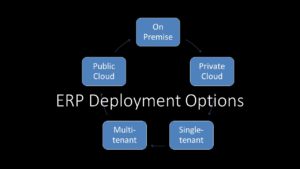If you’re confused by the different options, you are not alone. The vendors add to the confusion as they refer to the deployment options in different ways and they don’t include some of the options.
On premise has been around the longest and it’s easy to understand. You pay a one-time fee for the license and annual maintenance fees, but the vendors are all heading to the clouds.
The cloud is confusing as there are different types. A public cloud is hosted by the ERP vendor and includes all the software and data, also referred to as Software as a Service (SaaS). The public cloud could be on the vendor’s own cloud (such as Microsoft Azure) or on another cloud such as Amazon. The private cloud, sometimes referred to as Infrastructure as a Service (IaaS), also includes all software and data and is hosted but you need to purchase the software with a one-time license. A third party does the hosting rather than the ERP vendor.
Multi-tenant is the most confusing as it’s not a term used by the vendors that don’t offer it, which are most of the ERP vendors. On the other hand, vendors like Oracle NetSuite will say that any software not offering multi-tenant architecture is a fake cloud. Multi-tenant architecture allows one instance of the software to serve multiple companies at the same time, which brings down the costs of the hosting fees. All customers get upgraded at the same time and there are no upgrade fees. Single-tenant has higher costs as you have 1 instance of the software just for you and therefore higher costs for hosting and upgrades. But you have control when you upgrade (often referred to as cadence) and more control over customization should you have unique requirements not possible using the vendor’s configuration tools which provide customization outside of source code.
Finally, some vendors offer hybrid deployments which is also very confusing. Some vendors will store the software in the cloud, but the data is stored locally but with some exceptions as vendors are now mostly releasing new versions in the cloud for both data and software. Other vendors will give you the choice of what components of the software and data are stored locally, which can have advantages for mission critical applications such as POS where you can continue to run even if the internet is down or if you are concerned about exposing confidential information to a public cloud.
Another deployment option not seen a lot is open source whereby you don’t pay for the software – it’s free but you will need technical resources internally or externally to help you run the system.
We realize that you are probably still confused but hopefully we shed a little light through the clouds. Press the vendors to fully explain all the deployment options and don’t hesitate to contact us if you need more light.
